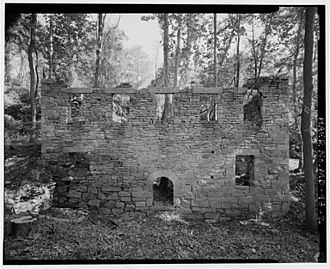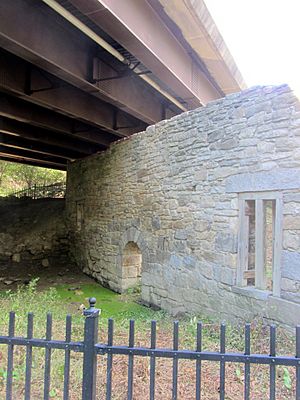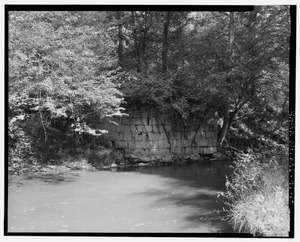Simpsonville Mill facts for kids
Quick facts for kids Simpsonville Mill |
|
|---|---|
 |
|
| General information | |
| Type | Grist Mill |
| Location | Cedar Lane, Columbia, Maryland |
| Coordinates | 39°11′18″N 76°53′40″W / 39.18829°N 76.89433°W |
| Completed | Mid 1700s |
The Simpsonville Mill is a very old mill complex in Simpsonville, Maryland. It is part of the Columbia, Maryland area today.
You can find the stone ruins of the mill under the Cedar Lane bridge. This bridge crosses the Middle Patuxent River. It is right next to the James and Anne Robinson Nature Center.
History of Simpsonville Mill
The Simpsonville Mill has had a few different names over time. It was once known as Joshua Warfield's mill and Richard Owing's Mill.
In 1741, John Hobbs Jr. bought land along the Middle Patuxent River. He sold it to Joshua Dorey in 1749. In 1768, Joshua Dorsey mentioned the stone mill in his will. This shows the mill was already built and working.
Vachel Worthington bought the property in 1789. Then, in 1796, Richard Owings bought 11 acres around the mill. He later expanded his land to 1000 acres. The Owings family ran several mills in the area. During the Napoleonic Wars (wars in Europe), flour prices went up a lot. This made the mills very profitable for a short time.
In 1852, Charles Ridgley Simpson bought 215 acres around the mill. The mill then started making wool cloth instead of grinding grain. It had six workers, six spindles, four looms, and two carders. William Simpson took over the mill after his brother died in 1854.
After the Civil War, William Bradshaw ran the mill from 1865 until 1877. The mill was then sold at an auction. The Ellicott City Times newspaper described it as a busy place:
A large three story woolen factory driven by a new turbine wheel of 25 horsepower. Grist Mill, and Saw Mill, Blacksmith and Wheelwright Shop. A Store Building with eight dwelling houses, A large switzer barn with stabling for twelve horses with all necessary farm buildings 215 acres under cultivation and good fencing
In 1878, James Simpson bought the mill, bringing it back to the Simpson family. They soon sold off some land and changed the mill back to grinding grain.
From 1904 to 1909, Charles R. and Mary Wilson owned the mill. Then, from 1909 to 1934, William Welling Iglehart and his brother John owned it. William Iglehart was a county commissioner. They used the building as a sawmill and a grist mill. It also had a cider mill in the basement before the time of Prohibition (when alcohol was illegal).
In 1920, a fire badly damaged the building. Most of the stone walls stayed standing. During the Great Depression, a company took over the property in 1934 because the Igleharts could not pay their mortgage.
In 1963, Howard Research and Development bought the property. This company was creating the new town of Columbia, Maryland. They bought the 58.5-acre site.
In 1993, a state highway project planned a new bridge over the Middle Patuxent River. This bridge would go over the Simpsonville Mill site. Before building, an archaeological dig was done. Workers found old homes, a blacksmith shop, and other shops. Part of the land became the Middle Patuxent Environmental Area. In 1994, the state announced the new bridge would have stone arches to match the historic mill.
In 2014, the mill site was put on a list of the most endangered historic places. This was because of delays in transferring the property. In 2015, ownership was given to Howard County. It is still on the endangered list today.
Simpson Mill Historic Area
The mill was the center of a small area with many important buildings. This area was considered special enough for the National Register of Historic Places.
Some important parts of this historic area included:
- The Hatfield residence: This house is built on a very old stone foundation from 1755. It was home to several mill owners.
- The Johnson site: This area has eight stone foundations related to the mill.
- The Robinson House and barn: These were next to the mill but were taken down in 2004 to build the James and Anne Robinson Nature Center.
- The Owings-Myerly House: This was a granite building from 1847. It was later taken down for a new road.
- Rock Quarries: There are two old rock quarries on the site.
- Owings Cemetery: This is a small cemetery with graves of the Owings Family.
- Water Control: This includes parts like the headrace, floodgate, and wheelpit. These helped control the water that powered the mill.
- Wheelwright Shop: This was a log cabin where wheels were made or fixed. It was moved in 1984 for a road project.
Historic American Engineering Record (HAER) No. MD-91, "Simpsonville Mill, West side of Cedar Lane at Guilford Road, Columbia, Howard County, MD", 11 photos, 35 data pages, 2 photo caption pages



